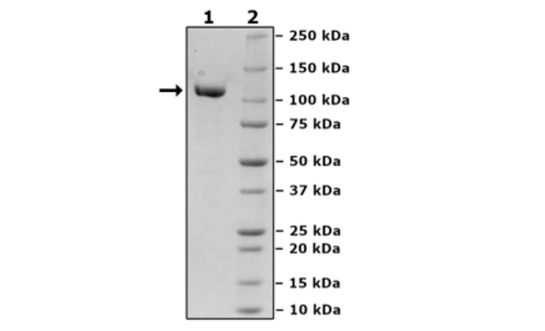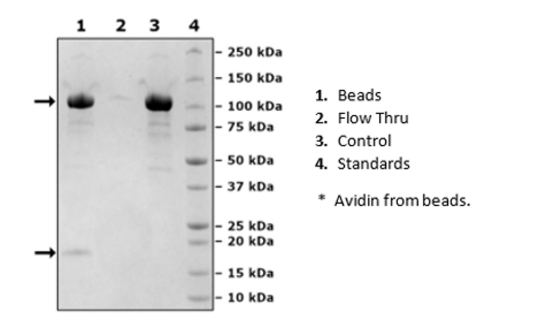TFRC (Transferrin Receptor), Avi-Tag, Fc Fusion, Biotinylated Recombinant
Recombinant human TFRC (transferrin receptor protein 1), encompassing amino acids 89-760 (end). The protein is fused at the N-terminus with the Fc fragment of a human IgG1 preceded by an Avi-Tag™. The recombinant protein was affinity purified.
≥90%
Aqueous buffer solution
8 mM phosphate, pH 7.4, 110 mM NaCl, 2.2 mM KCl, and 20% glycerol
This protein is enzymatically biotinylated using Avi-Tag™ technology. Biotinylation is confirmed to be ≥90%.
For more information on enzymatic biotinylation, please see our Tech Note.
Transferrin Receptor Protein 1 (TFRC) is a cell surface receptor that binds ferric-iron-loaded transferrin in the bloodstream at high affinity to facilitate iron uptake into cells. TFRC is therefore an integral component of the body’s iron supply chain and general homeostasis. Intracellular iron levels, hypoxia and CRE signaling regulate TFRC transcription. In addition, TFRC is upregulated in correlation with tumor-progressive stages of multiple forms of cancer. At the cellular level iron surplus results in oxygen radical formation and cellular dysfunction, while iron deficiency can cause rapid cell death. Deregulated iron levels are therefore correlated with multiple disease states including Parkinson’s Disease, Amyotrophic Lateral Sclerosis (ALS), Huntington’s Disease, Multiple Sclerosis (MS), and tumorigenesis. As TFRC is upregulated on the surface of tumor cells, it has been targeted to inhibit adult T-cell leukemia/lymphoma. Additionally, TFRC has found important utility in treatments of neurological diseases.



